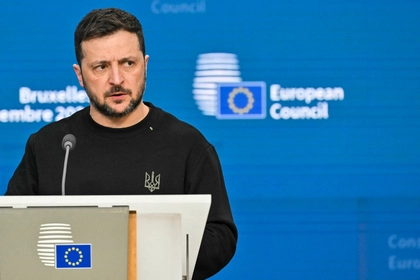The decades-old political complaint about German hesitance to take the lead for continental defense and security may end next week, with Berlin set to provide military support to Ukraine on a scale unmatched in Europe and rivalling the Americans’ – provided Germany’s ruling SPD-Greens-FDP coalition passes the legislation.
Defense Minister Boris Pistorius on Nov. 12 announced the government intended to ask for the Bundestag to increase military aid to Ukraine financed by German taxpayers, for 2024, from €4 billion to €8 billion. The Budget Committee would vote on the measure in the following week, he said.
JOIN US ON TELEGRAM
Follow our coverage of the war on the @Kyivpost_official.
The state spending amendment is likely to pass given the ruling coalition’s usually reliable majority control of the national legislature.
As of today, Germany is by overall value the second-largest source of weapons and combat materials to Kyiv, having promised or delivered to Ukraine €17.1 billion of military aid in all forms from late January 2022 to July 2023. Over the same 18-month period, the US delivered or committed about €41.1 billion worth of arms and military supply.
The probable €4 billion spike in German military support to Ukraine over 2024 will, for one thing, almost double the value of support given to Kyiv by Ukraine’s next most deep-pocketed ally, the United Kingdom, an analysis of international support to Ukraine data compiled by the Kiel Institute for World Economy showed.

‘It Has Gone on Far Too Long’ – Ukraine at War Update for Dec. 20
The commitment would likely cement Germany’s position as a key leader in real military support to Ukraine, especially one that could be depended on for the longer term. By most estimates, the US national economy, worth about $23.3 trillion annually, is about five times bigger than the German national economy with an annual GDP of $4.26 trillion, and the US population of 332 million is about four times larger than Germany’s 82.3 million citizens.
Germany set to surpass the US in aid
If and when paid, and assuming no substantial increase of US military support to Ukraine, by the end of 2024, US defense assistance to Ukraine would be roughly twice Germany’s, and less than half the German contribution on a per capita basis, by those figures.
The German commitment to continental security and Ukrainian defense came against a background of raucous partisan fighting in the US Congress and in pre-election debates over military aid to Ukraine. Most but not all Democrats support continued substantial aid to Ukraine, while Republicans are split between cutting Ukraine off completely and handing over to Kyiv America’s most sophisticated weapons in sufficient quantity to defeat Russia in short order. Currently, the US legislature is deadlocked on a 2024 spending bill.
Unlike some parts of US or British military assistance to Ukraine needed to be returned or paid for once the war with Russia ends, according to German news reports, German military assistance to Ukraine is almost without exception a one-way transfer by German taxpayers to Ukraine’s armed forces.
According to a Bild news magazine report, the Berlin commitment to Ukraine is only part of the biggest shift in German security and defense spending priorities since the end of the Cold War, led by a planned €100 billion program intended to rearm and make Germany’s hollowed-out national army, the Bundeswehr, combat-capable again.
German Chancellor Olaf Scholz (SPD), speaking on Friday at a Bundeswehr conference, said German defense spending will be in the double-digit range into the next decade, and Germany will reach NATO’s 2 percent of total GDP defense spending target for the first time in 2024, Bild reported.
Germany and the Scholz government at the outset of Russia’s invasion of Ukraine in February 2022 was hesitant to send significant military assistance to Kyiv, with initial deliveries focusing on personal medical equipment, body armor, ambulances and helmets. Forced delays often lasted months, as armored personnel carrier transfers to Ukraine from other European states, which had originally received the vehicles from Germany, hit bureaucratic snags.
Berlin’s about-face
Berlin’s willingness to hand over lethal weapons to Ukraine turned around in Spring 2023 with the handover of Marder and M-113 combat vehicles, Dingo armored cars, Leopard tanks, PzH 2000 and Zuzana self-propelled howitzers and Mars rocket launchers collectively numbering some 200 armored vehicles.
Particularly effective and popular German arms deliveries, in Ukraine, have been 60 Cold War-era Gepard mobile anti-aircraft cannon, eight modern IRIS-T anti-aircraft missile systems, and a pair of state-of-the-art Patriot air defense systems, all now used widely to protect Ukrainian air space and cities from Russian bombardment by cruise and ballistic missiles, and kamikaze drones.
Neither Pistorius nor Scholz offered specifics on what weapons the additional German arms funding would purchase for Ukraine.
Looking for longer range
Almost certainly, from Kyiv’s point of view, the Berlin-supplied weapon most needed by Ukraine would be the Taurus cruise missile, the German version of a medium-range, precision-guided munition also produced by Britain as the Storm Shadow missile, and by France as the SCALP missile.
Kyiv reportedly first received Storm Shadows and SCALPs in September and used them with devastating effects against Russia’s Black Sea Fleet (BSF), in a series of September strikes against Kremlin naval facilities in Crimea. The NATO-standard missiles fired in salvoes of two to four weapons penetrated dense Russian air defenses and hit an amphibious assault ship, an attack submarine, and three military drydocks.
One Storm Shadow demolished BSF headquarters as a command staff meeting was in progress, according to news reports, killing or wounding more than two dozen senior officers including the fleet commander. Russia evacuated almost all of its warships from Sevastopol, in a naval retreat last seen in 1941.
The Scholz government in early October, those strikes’ success notwithstanding, reiterated a longstanding refusal for Berlin to send its version of the cruise missile to Kyiv, the German leader arguing the transfer would not have a decisive effect on the war in Ukraine.
That stance has come under vicious fire from Germany’s opposition and, according to some reports, within the ranks of Scholz’s own coalition. On Friday the center-right CDU/CSU faction made a formal call for a resolution to be voted on by the Bundestag in the next seven days or less, on delivering Taurus missiles to Ukraine “immediately.” The junior members of Scholz’s ruling majority, the Greens and the Liberals, mostly support the transfer, the Swiss Neue Züriche Zeitung reported.
In Sunday comments published by the German information platform RBB 24 Inforadio, German Federal Development Minister Svenja Schulze (SPD) said that, beyond military assistance, reconstruction aid for Ukraine must be increased.
“We have to help Ukraine defend itself against Russia’s attack… This must be done militarily on the one hand, but also through civilian help. Reconstruction aid must increase. There is an incredible amount of destruction. The people who live in Ukraine need electricity, water and a roof over their heads,” Schulze said.
You can also highlight the text and press Ctrl + Enter






